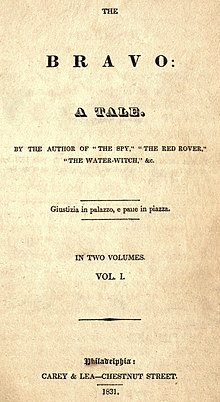The Bravo
 First edition title page | |
| Author | James Fenimore Cooper |
|---|---|
| Language | English |
| Genre | Novel |
| Publisher | Carey & Lea |
Publication date | 1831 |
| Publication place | United States |
The Bravo is a novel by James Fenimore Cooper first published in 1831 in two volumes. Inspired by a trip to Europe where he traveled through much of Italy, the novel is set in Venice. The Bravo is the first of Cooper's three novels to be set in Europe.[1] This group of three novels, which one critic would call Cooper's "European trilogy", include The Heidenmauer and The Headsman.[2] Like his other novels set in Europe, The Bravo was not very well received in the United States.[3] The book largely focuses on political themes, especially the tension between the social elite and other classes.
Background
In 1829–1830, Cooper toured Italy with his wife and family.[4] Starting in Florence, where he spent considerable time absorbing the Tuscan culture, Cooper departed on a sailing trip around Italy, visiting many historic cities including Genoa, Marseille and much of Southern Italy. In Sorrento, Cooper finished The Water-Witch, after which, he again departed, sailing again through the Adriatic. Upon reaching Venice, Cooper was so struck by the architecture that he was inspired to write the novel that would become The Bravo.[5]
Plot
Style
In The Bravo, Cooper uses lightness and darkness to paint the scenes. However, unlike some of his other books, The Bravo is predominated by dark settings and language. Following his political themes, the official political powers in the novel are often draped in dark settings. In this context, the few chapters which present Venice as brightly lit, depict daylight as a hypocritical false front. However, Moonlight, unlike sunlight and artificial lighting, illuminates scenes of hope to overcome the dark "official Venice".[6]
Themes

The Bravo deals with many political themes. Cooper would later explain that he wrote the novel because " the great political contest of the age was not, as is usually pretended, between the two antagonist principles of monarchy and democracy, but in reality between those who, under the shallow pretense of limiting power to the elite of society, were contending for exclusive advantages at the expense of the mass of their fellow-creature."[1] He saw under Europe's old order and lush surface, "an oppressive social order without any sense of divine law in nature" which sat in antithesis to America's unexplored wilderness and less structured society.[7] To Cooper, Venice's government is unable to meet the demands of its citizens, even representing its aristocrats as victims.[8]
Adaptations
The novel was adapted into a play, La Vénétienne, by Auguste Anicet-Bourgeois; this in turn served as the basis for an opera, Il bravo, by Saverio Mercadante, which premiered in 1839 at La Scala.[9]
References
- ^ a b Loveland, Anne C. (Summer 1969). "James Fenimore Cooper and the American Mission". American Quarterly. 21 (2, Part 1). The Johns Hopkins University Press: 244–258. doi:10.2307/2711577. JSTOR 2711577.
- ^ Collins, Frank M. (March 1966). "Cooper and the American Dream". Publications of the Modern Language Association of America. 81 (1). Modern Language Association: 79–94. doi:10.2307/461311. JSTOR 461311. S2CID 163784515.
- ^ Zoellner, Robert H. (Spring 1961). "Fenimore Cooper: Alienated American". American Quarterly. 13 (1). The Johns Hopkins University Press: 55–66. doi:10.2307/2710512. JSTOR 2710512.
- ^ "13. The Bravo". The Freeman's Journal. The Otsego Templeton Publishing Company. Retrieved November 19, 2020 – via James Fenimore Cooper Society.
- ^ Goggio, Emilio (January 1945). "The Italy of James Fenimore Cooper". The Modern Language Journal. 29 (1). Blackwell Publishing on behalf of the National Federation of Modern Language Teachers Associations: 66–71. doi:10.1111/j.1540-4781.1945.tb03339.x. JSTOR 318108.
- ^ Ringe, Donald A. (September 1963). "Chiaroscuro as an Artistic Device in Cooper's Fiction". Publications of the Modern Language Association of America. 78 (4). Modern Language Association: 349–357. doi:10.2307/461247. JSTOR 461247. S2CID 163171302.
- ^ Marder, Daniel (Summer 1985). "Cooper's Second Cycle". South Central Review. 2 (2). Johns Hopkins University Press on behalf of The South Central Modern Language Association: 23–37. doi:10.2307/3189147. JSTOR 3189147.
- ^ Becker, George J. (March 1956). "James Fenimore Cooper and American Democracy". College English. 17 (6). National Council of Teachers of English: 325–334. doi:10.2307/372369. JSTOR 372369.
- ^ Casaglia, Gherardo (2005). "Il bravo, 9 March 1839". L'Almanacco di Gherardo Casaglia (in Italian).
Further reading
- Ringe, Donald A. (July 1991). George A. Test (ed.). The Bravo : Social Criticism in the Gothic Mode. 8th Cooper Seminar, James Fenimore Cooper: His Country and His Art. State University of New York at Oneonta: James Fenimore Cooper Society. pp. 124–134.
External links
- The Bravo (London 1831, 3 volumes) at Open Library
- The Bravo (New York 1860, 1 volume) on Google Books
